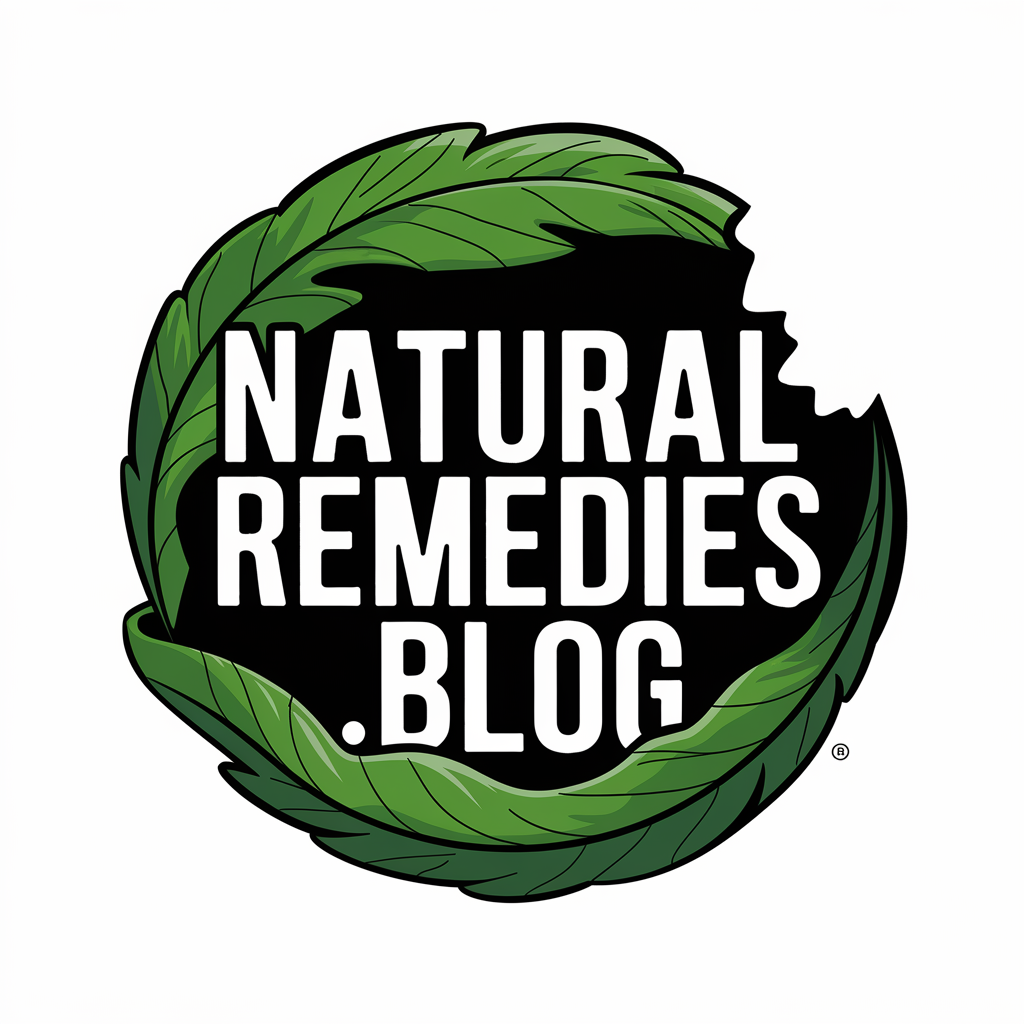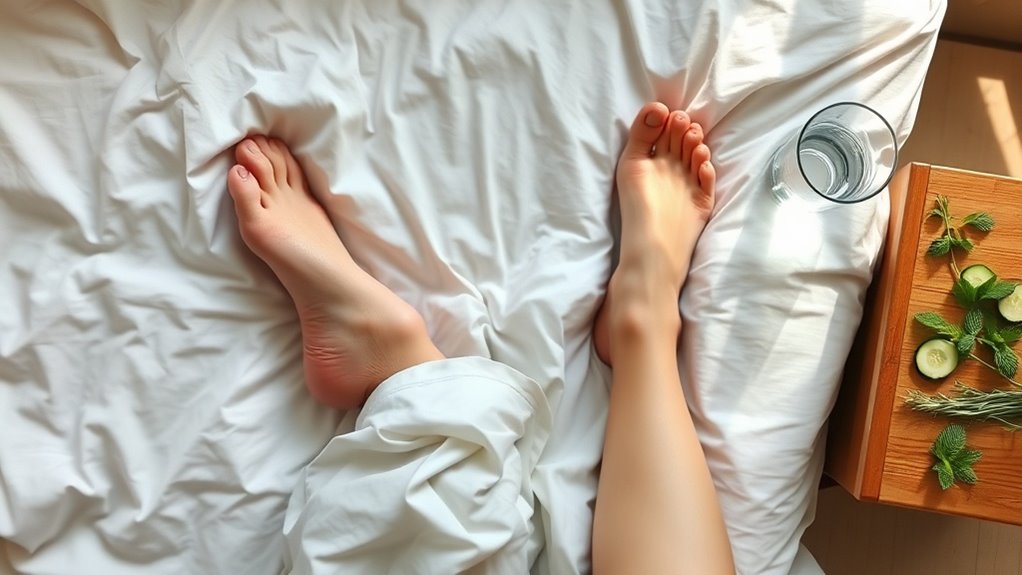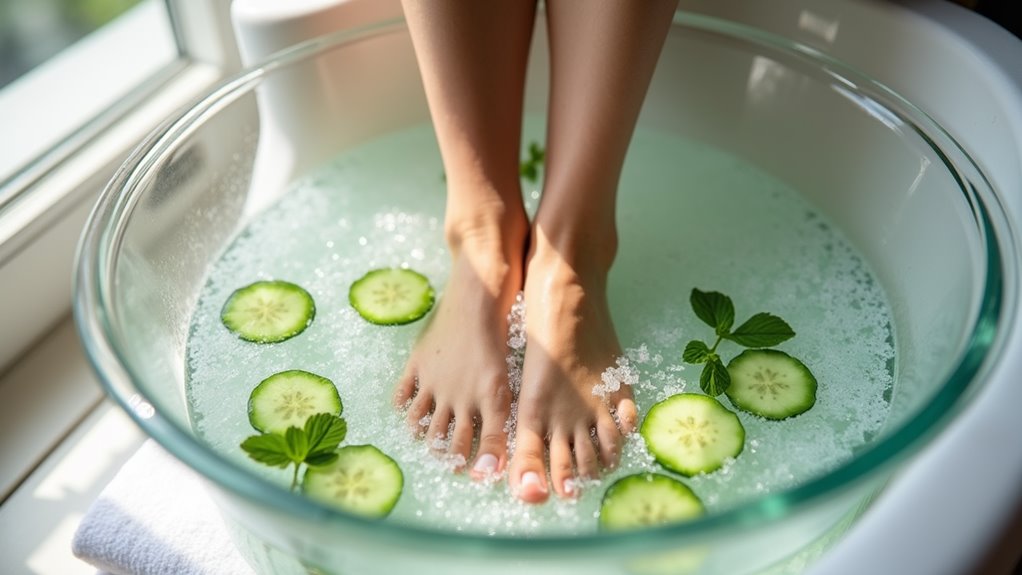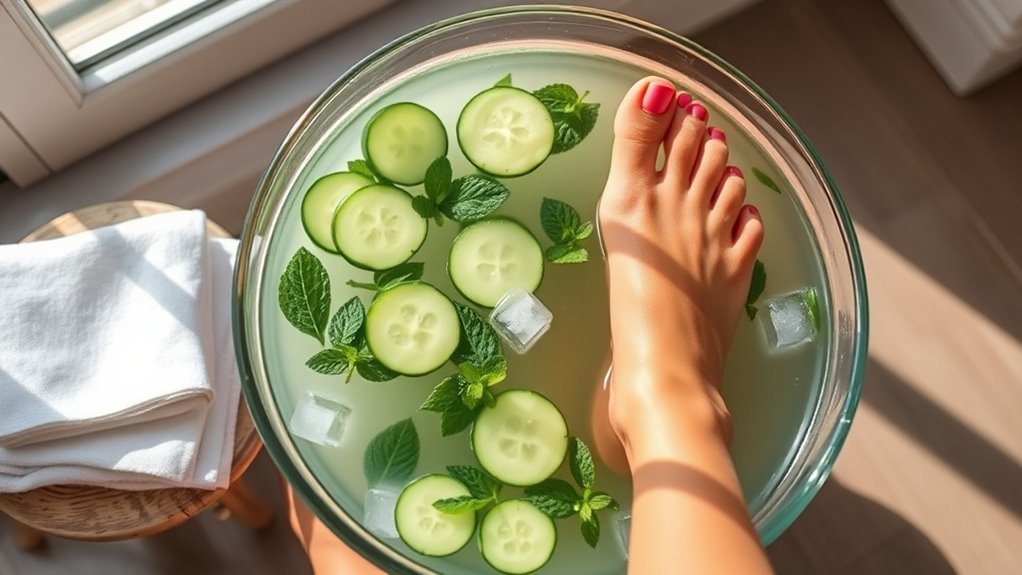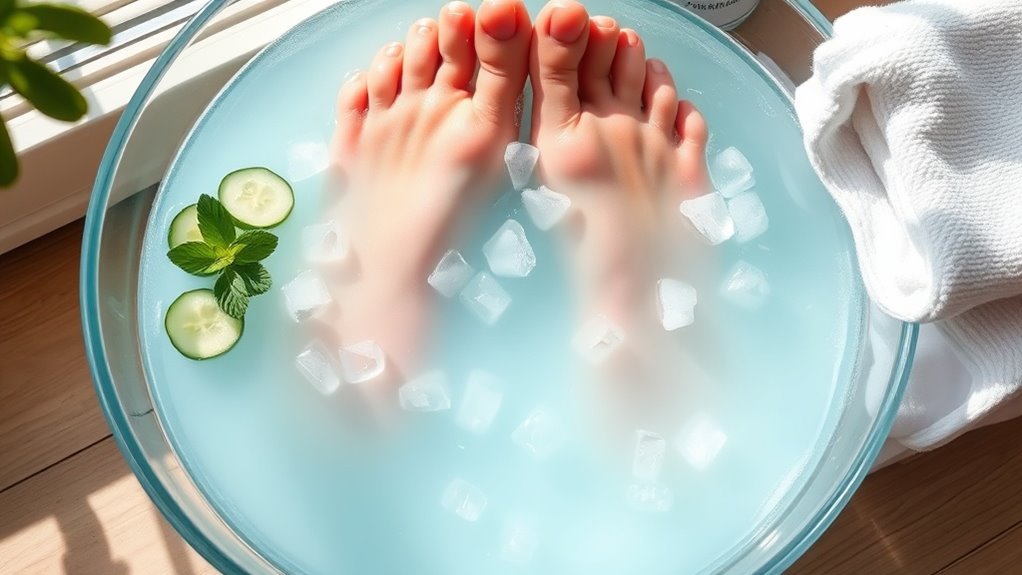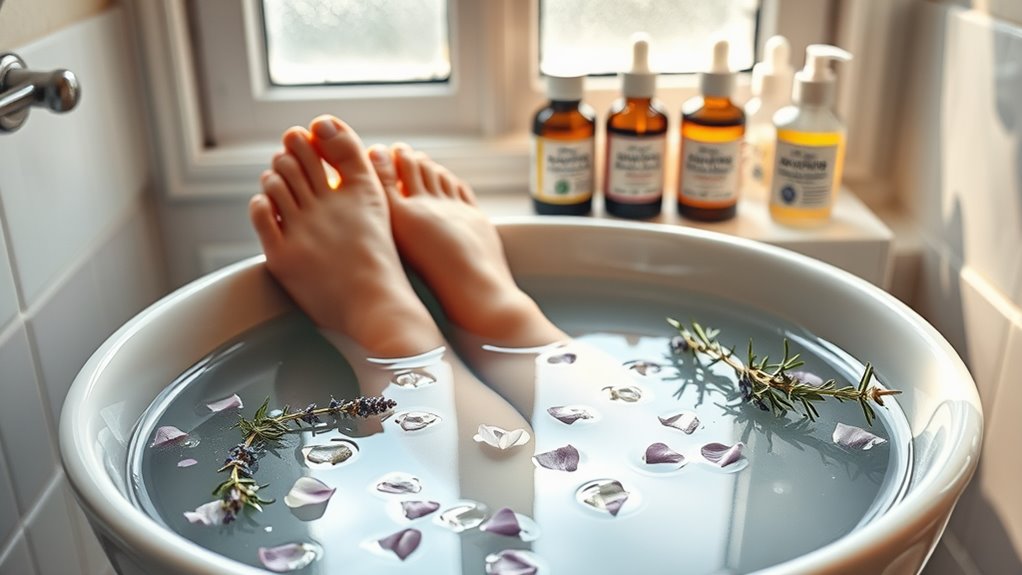My Swollen Feet Were Gone in One Day After This
Understanding Swollen Feet: Causes and Symptoms
When your feet become swollen, excess fluid accumulates in the tissues of your feet and ankles through a process called edema.
This condition can result from prolonged standing, pregnancy, or underlying medical conditions affecting your circulatory or lymphatic systems. Common symptoms include stretched skin, difficulty fitting into shoes, and discomfort when walking.
Before trying swollen feet remedies, it’s essential to identify the root cause. Your feet may swell due to heart problems, kidney disease, blood clots, or medication side effects.
You’ll notice pitting edema when pressing your thumb into the swollen area leaves an indentation that slowly rebounds. Recognizing these signs is crucial for timely medical intervention.
My Personal Journey With Foot Swelling
When you first noticed the bilateral pedal edema in your feet, you couldn’t identify whether it stemmed from prolonged standing at work or underlying venous insufficiency.
Your daily experience included watching your ankles disappear by mid-afternoon, accompanied by uncomfortable pressure in your metatarsal region and difficulty fitting into your regular footwear.
Through careful observation and medical consultation, you finally discovered that reducing sodium intake and implementing compression therapy provided the quickest path to managing your symptoms. Additionally, you learned that simple lifestyle changes like daily walking and elevating your feet can significantly help reduce swelling.
Discovering the Root Cause
After struggling with persistent foot swelling for months, I began documenting every possible factor that could trigger these episodes. Through careful tracking, I identified key patterns affecting my lymphatic drainage and venous return.
| Trigger Factor | Physiological Impact |
|---|---|
| Extended Standing | Compromised venous flow |
| High Sodium Diet | Fluid retention |
| Tight Footwear | Restricted circulation |
The breakthrough came when I noticed the swelling worsened after prolonged periods of immobility and salt-heavy meals. Your feet’s interstitial fluid balance depends heavily on movement and dietary choices. Understanding these triggers helped me develop targeted interventions for my peripheral edema.
My Daily Swelling Struggles
Throughout my battle with pedal edema, mornings typically started with minimal swelling but progressed to significant discomfort by mid-afternoon. My metatarsal region would expand, making shoes increasingly tight.
By evening, the swelling extended from my toes to my ankles, creating visible pitting when pressed. Standing for long periods exacerbated the condition, causing my ankle bones to disappear beneath puffy tissue.
The constant pressure made walking painful, particularly around the dorsal region of my feet. Even my usual comfortable shoes became constrictive torture devices, forcing me to switch to open-toed sandals regardless of the weather.
Quick Relief at Last
Three simple changes revolutionized my battle against pedal edema.
You’ll notice immediate relief when you elevate your feet above heart level for 20 minutes, allowing gravity to assist lymphatic drainage.
Next, compress your ankles with medical-grade compression socks, targeting 20-30 mmHg pressure to reduce fluid accumulation in the interstitial spaces.
Finally, perform ankle pumps – flexing and extending your talocrural joint 30 times hourly. This combination activates your skeletal-muscle pump, enhances venous return, and reduces hydrostatic pressure in your lower extremities.
The swelling subsides remarkably within 24 hours.
The Simple Solution That Changed Everything
You’ll find remarkable relief from swollen feet using a simple at-home method that targets fluid accumulation in your lower extremities.
By elevating your feet above heart level for 20 minutes while performing ankle rotations, you’re activating your body’s natural lymphatic drainage system. This anatomically-sound technique succeeds because it combines gravitational assistance with muscular engagement, effectively reducing interstitial fluid buildup in your feet’s soft tissues. Additionally, the use of Epsom salt soaks can further enhance the benefits by drawing excess fluid from the tissues.
Natural Remedy At Home
After suffering from fluid retention and discomfort in your lower extremities, a simple yet effective home remedy can provide significant relief.
You’ll need to combine one cup of Epsom salt with warm water in a foot basin. Immerse your feet for 15-20 minutes, allowing the magnesium sulfate to penetrate your skin and reduce inflammation.
For enhanced results, alternate between warm and cool water every five minutes. This temperature contrast stimulates circulation and lymphatic drainage in your feet and ankles.
Elevate your feet above heart level afterward, and gently massage from toes to ankles using circular motions to promote fluid dispersal.
Quick Relief Method Works
While soaking methods can help manage swollen feet, a groundbreaking compression technique has revolutionized rapid relief for edema sufferers.
| Time | Action |
|---|---|
| 0-5 min | Elevate feet 45° above heart |
| 5-10 min | Apply circular massage to ankles |
| 10-15 min | Flex toes and rotate feet |
| 15-20 min | Compress with graduated pressure |
You’ll notice immediate circulation improvement as excess fluid drains from your peripheral tissues. This technique targets the lymphatic system’s natural drainage pathways, reducing interstitial fluid buildup in your feet. By engaging your plantar fascia and activating venous return, you’re effectively combating gravitational pooling that causes foot swelling.
Why This Solution Succeeds
Because the compression technique directly targets the body’s natural fluid regulation mechanisms, it provides superior results compared to traditional swelling remedies.
The pressure you apply stimulates your lymphatic system, enhancing fluid drainage from your feet and ankles.
Your body’s venous return improves when you elevate your feet while using graduated compression. This combination reduces hydrostatic pressure in your lower extremities.
The technique also increases blood flow through your foot’s venous networks, helping remove excess interstitial fluid that causes edema. Your capillaries respond by normalizing fluid exchange, effectively reducing swelling within hours.
Step-by-Step Guide to Reducing Foot Swelling
Since foot swelling often results from fluid retention in the lower extremities, addressing this condition requires a systematic approach to restore proper circulation and lymphatic drainage.
First, elevate your feet above heart level for 20 minutes.
Next, perform ankle rotations – 10 clockwise, 10 counterclockwise.
Then, flex and point your toes for 30 seconds each.
Follow with gentle lymphatic massage, starting at your toes and working upward toward your ankles using light pressure.
Finally, walk for 10 minutes to stimulate blood flow.
Repeat this sequence three times daily, especially after long periods of sitting or standing. Additionally, limiting excessive salt intake can help reduce fluid retention and enhance the effectiveness of these techniques.
Natural Remedies and Lifestyle Changes
In addition to targeted exercises, several natural remedies and lifestyle modifications can help reduce pedal edema. You’ll find relief by implementing these evidence-based solutions targeting fluid retention in your lower extremities.
| Natural Remedy | Benefit |
|---|---|
| Epsom Salt Soak | Draws excess fluid from tissues |
| Compression Socks | Promotes venous return |
| Dandelion Tea | Acts as natural diuretic |
| Elevation Above Heart | Assists lymphatic drainage |
To maximize these interventions’ effectiveness, you’ll want to reduce your sodium intake, maintain proper hydration, and avoid prolonged periods of immobility. These strategies help normalize interstitial fluid balance while supporting your body’s natural circulatory mechanisms. Additionally, understanding the common causes of edema can further inform your approach to managing swollen feet.
Prevention Tips for Long-Term Relief
While treating swollen feet provides temporary relief, implementing preventive measures can help you maintain long-term foot health and minimize recurrent edema.
To prevent fluid retention, elevate your feet above heart level during rest periods and maintain proper circulation by avoiding prolonged sitting or standing.
Wear compression socks during physical activity and travel. Choose breathable, properly-fitted footwear that doesn’t constrict your feet or ankles.
Monitor your sodium intake and stay hydrated with adequate water consumption.
Regular ankle exercises and gentle foot massage can improve lymphatic drainage.
If you’re prone to edema, schedule movement breaks throughout your day and maintain a healthy body weight.
When to Seek Medical Attention
Knowing when to seek professional medical evaluation for swollen feet can prevent serious complications.
While some swelling is temporary, certain symptoms require immediate medical attention to avoid potential vascular or systemic issues.
-
Persistent swelling that doesn’t improve after 24 hours of elevation and rest
-
Severe pain in your ankles or feet accompanied by redness, warmth, or skin changes
-
Unilateral swelling (one foot significantly more swollen than the other), which may indicate deep vein thrombosis
-
Swelling accompanied by shortness of breath, chest pain, or sudden weight gain, suggesting possible heart or kidney problems
Daily Foot Care Maintenance Routine
A comprehensive daily foot care routine forms the foundation for preventing and managing swollen feet.
Begin each morning by inspecting your feet for signs of discoloration, blisters, or unusual swelling. Wash your feet thoroughly with lukewarm water, paying attention to the spaces between toes. Pat them dry completely to prevent fungal growth.
Apply moisturizer to prevent skin cracking, but avoid between toes. Rotate through different pairs of breathable, properly-fitted shoes daily.
End your day with gentle foot exercises: flex your ankles, rotate your feet, and spread your toes. Elevate your feet above heart level while sleeping.
